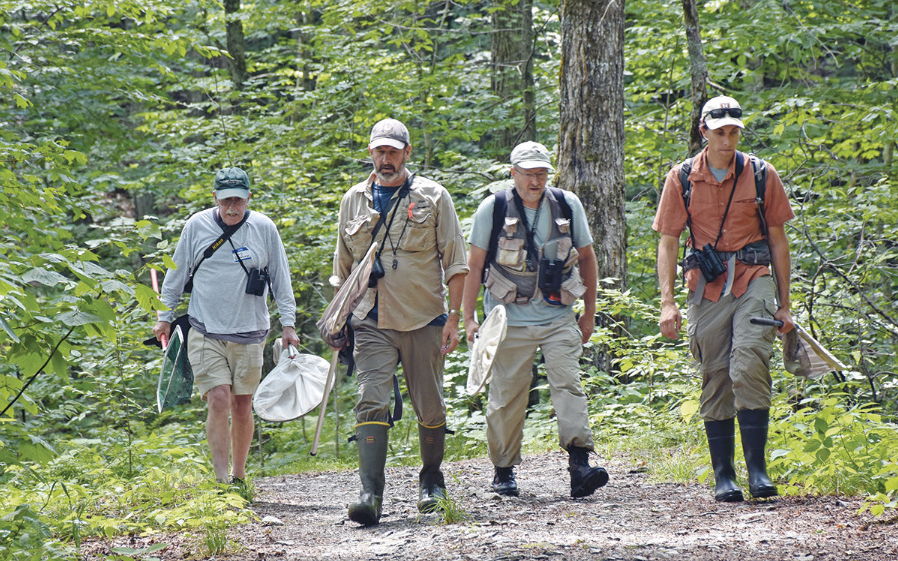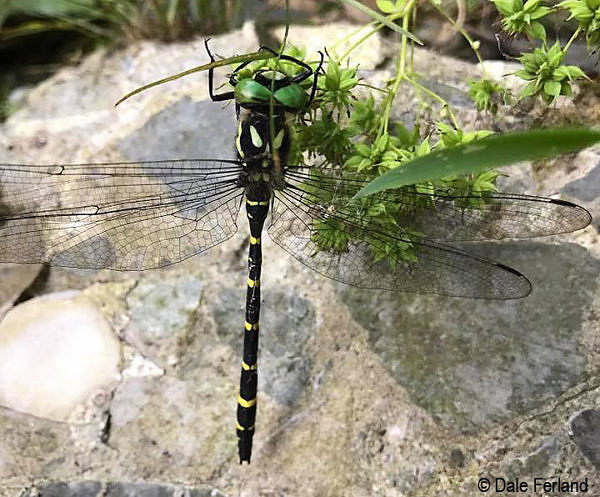Vermont Dragonfly and Damselfly Atlas – Season Summary: 10,000 Odes and Growing

From left, Doug Burnham, Bryan Pfeiffer, Mike Blust and Sean Beckett on dragonfly duty during a BioBlitz at Babcock Nature Preserve in Eden, Vermont, this summer.
Blogger’s Note: Here’s my informal annual report for the Vermont Dragonfly and Damselfly Atlas, a project of the amazing Vermont Atlas of Life.
BY MOST ANY MEASURE, the 2017 field season of the Vermont Dragonfly and Damselfly Atlas (VDDA) was satisfying, surprising … and nearly heart-stopping.
The project’s brigade of volunteers added 1,605 records to our growing dataset, which now stands at 10,544 records. That includes the addition of two new species to the Vermont fauna in 2017: Cordulegaster erronea (Tiger Spiketail) and Somatochlora incurvata (Incurvate Emerald).
Before we get to the news on those additions, perhaps the best news in Odonata this year was that the Vermont Center for Ecostudies (VCE) brought our collective data online. On April 21, as the first Anax junius (Common Green Darners) were cruising into Vermont, VCE made more than a century of Odonata data freely accessible to the world, thanks in large part to the work of Senior Biologist Kent McFarland. It’s all part of the Vermont Atlas of Life.
VDDA now covers 145 confirmed Odonata species in the state: 101 dragonflies (Anisoptera) and 44 damselflies (Zygoptera). But we’re not done. In our atlas, every dragonfly counts, even common species. So we continue to grow our dataset with contributions from skilled odonatologists and casual observers alike. Thanks to everyone who contributed this year, a total of 120 people, pushing us past the 10,000-record mark. It’s a tremendous achievement for a small state.

Cordulegaster erronea (Tiger Spiketail)
After we launched the project online, the first big news came from the Black River in Springfield. On July 31, Dale Ferland, an angler who likes to poke around rivers, snapped a photo of a dragonfly perched on the shoreline. Kelly Stettner, who’s doing great work educating folks about the river, posted Dale’s image to iNaturalist Vermont, where project curators first saw it. Needless to say, we were happy — and surprised. It was Vermont’s first Cordulegaster erronea (Tiger Spiketail).
This handsome dragonfly inhabits streams and rivers east of the Mississippi River, and rarely gets this far north. Spiketails are so named for the females, which lay their eggs by hovering and plunging their spiked ovipositors, like sewing machines, into flowing water. Dale’s find turned out to be the 100th dragonfly species we know of here in Vermont. Whether we’ve got a resident population of Tiger Spiketails, or whether this is a one-off, remains to be seen. We’ll be back to the site next year. (In a similarly rare encounter, our colleague Josh Rose also found this species in Massachusetts on June 25, 2017.) In any event, congratulations are due to Dale and Kelly!
The other big discovery, not so much a surprise, was bittersweet for me (your humble VDDA co-coordinator). I’ve spent many years in Vermont peatlands searching unsuccessfully for Somatochlora incurvata (Incurvate Emerald). In August, I hatched a late-season plan with Josh Lincoln to search for this rare dragonfly in a remote section of Victory Basin Wildlife Management Area, in Vermont’s Northeastern Highlands. The expedition required about two hours of bushwhacking and mucking through wetlands to reach the site.
My plan might have worked — except that I went down with a heart attack on August 26, a few days before Josh and I had intended to get to Victory. (I’m doing fine now, by the way.) As I was recovering, on September 16, Josh and Mike Blust set out on the Victory slog. And after the two-hour march, and then 45 minutes on the bog, each of them had achieved victory in Victory: at long last, Vermont’s first Somatochlora incurvata (Incurvate Emerald). This elusive species is among the rarest North American dragonflies, known only from scattered records throughout the upper Midwest and northeastern North America. We continue to seek out additional sites for it in Vermont. Read more about Josh and Mike’s discovery on the VCE blog.
Had Josh and I instead made that fateful trip to Victory, yes, indeed, we might have finally landed S. incurvata in Vermont. It would have been great. But it might have been the last dragonfly I had ever encountered on this good earth.
So congratulations to Josh and Mike. Meanwhile, I live on to find more dragonflies in this state. You can join the effort. If you’d like to learn more about dragonflies, and how to discover and enjoy them, send me an email. I’ll keep you posted on project training sessions and workshops next year.

Great article, Bryan!